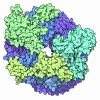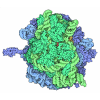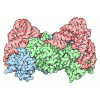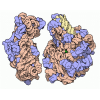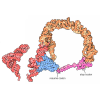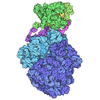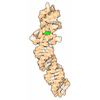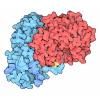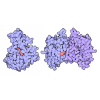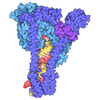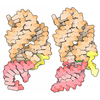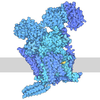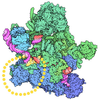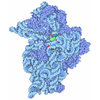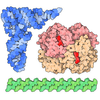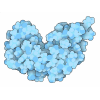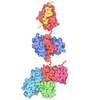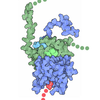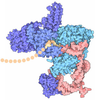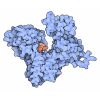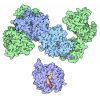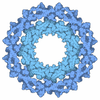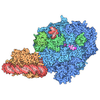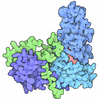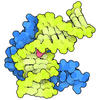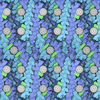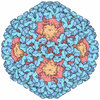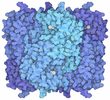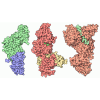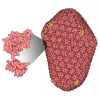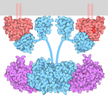+ Open data
Open data
- Basic information
Basic information
| Entry | Database: PDB / ID: 9g8m | ||||||||||||||||||
|---|---|---|---|---|---|---|---|---|---|---|---|---|---|---|---|---|---|---|---|
| Title | human 80S ribosome bound by a SKI2-exosome complex | ||||||||||||||||||
 Components Components |
| ||||||||||||||||||
 Keywords Keywords | RIBOSOME / RNase / Helicase / RNA-binding / mRNA-degradation / cytoplasm | ||||||||||||||||||
| Function / homology |  Function and homology information Function and homology informationDNA deamination / nucleolar exosome (RNase complex) / exoribonuclease II activity / exoribonuclease II / Dom34-Hbs1 complex / nuclear-transcribed mRNA catabolic process, no-go decay / U1 snRNA 3'-end processing / U5 snRNA 3'-end processing / TRAMP-dependent tRNA surveillance pathway / Ski complex ...DNA deamination / nucleolar exosome (RNase complex) / exoribonuclease II activity / exoribonuclease II / Dom34-Hbs1 complex / nuclear-transcribed mRNA catabolic process, no-go decay / U1 snRNA 3'-end processing / U5 snRNA 3'-end processing / TRAMP-dependent tRNA surveillance pathway / Ski complex / CUT catabolic process / exosome (RNase complex) / U4 snRNA 3'-end processing / cytoplasmic exosome (RNase complex) / nuclear polyadenylation-dependent rRNA catabolic process / poly(A)-dependent snoRNA 3'-end processing / mRNA decay by 3' to 5' exoribonuclease / nuclear exosome (RNase complex) / nuclear-transcribed mRNA catabolic process, 3'-5' exonucleolytic nonsense-mediated decay / exonucleolytic trimming to generate mature 3'-end of 5.8S rRNA from tricistronic rRNA transcript (SSU-rRNA, 5.8S rRNA, LSU-rRNA) / Tristetraprolin (TTP, ZFP36) binds and destabilizes mRNA / ATF4 activates genes in response to endoplasmic reticulum stress / histone mRNA catabolic process / Butyrate Response Factor 1 (BRF1) binds and destabilizes mRNA / positive regulation of isotype switching / 3'-5' RNA helicase activity / nuclear mRNA surveillance / rRNA catabolic process / 7S RNA binding / eukaryotic 80S initiation complex / negative regulation of protein neddylation / response to insecticide / mRNA 3'-UTR AU-rich region binding / oxidized pyrimidine DNA binding / response to TNF agonist / positive regulation of base-excision repair / negative regulation of endoplasmic reticulum unfolded protein response / isotype switching / negative regulation of peptidyl-serine phosphorylation / regulation of G1 to G0 transition / axial mesoderm development / negative regulation of formation of translation preinitiation complex / positive regulation of intrinsic apoptotic signaling pathway in response to DNA damage / positive regulation of respiratory burst involved in inflammatory response / ribosomal protein import into nucleus / regulation of translation involved in cellular response to UV / positive regulation of gastrulation / regulation of adenylate cyclase-activating G protein-coupled receptor signaling pathway / protein-DNA complex disassembly / protein tyrosine kinase inhibitor activity / 90S preribosome assembly / IRE1-RACK1-PP2A complex / positive regulation of endodeoxyribonuclease activity / nucleolus organization / positive regulation of Golgi to plasma membrane protein transport / translation at postsynapse / positive regulation of intrinsic apoptotic signaling pathway in response to DNA damage by p53 class mediator / TNFR1-mediated ceramide production / ribosome disassembly / negative regulation of DNA repair / negative regulation of RNA splicing / RNA catabolic process / mammalian oogenesis stage / GAIT complex / A band / positive regulation of DNA damage response, signal transduction by p53 class mediator / supercoiled DNA binding / activation-induced cell death of T cells / TORC2 complex binding / alpha-beta T cell differentiation / NF-kappaB complex / neural crest cell differentiation / G1 to G0 transition / oxidized purine DNA binding / cysteine-type endopeptidase activator activity involved in apoptotic process / positive regulation of ubiquitin-protein transferase activity / negative regulation of intrinsic apoptotic signaling pathway in response to hydrogen peroxide / exit from mitosis / ubiquitin-like protein conjugating enzyme binding / regulation of establishment of cell polarity / translation at presynapse / middle ear morphogenesis / Formation of the ternary complex, and subsequently, the 43S complex / negative regulation of phagocytosis / rRNA modification in the nucleus and cytosol / erythrocyte homeostasis / optic nerve development / KSRP (KHSRP) binds and destabilizes mRNA / cytoplasmic side of rough endoplasmic reticulum membrane / laminin receptor activity / maturation of 5.8S rRNA / retinal ganglion cell axon guidance / negative regulation of ubiquitin protein ligase activity / protein kinase A binding / ion channel inhibitor activity / nuclear chromosome / Ribosomal scanning and start codon recognition / pigmentation / homeostatic process / response to aldosterone Similarity search - Function | ||||||||||||||||||
| Biological species |  Homo sapiens (human) Homo sapiens (human) Cricket paralysis virus Cricket paralysis virus | ||||||||||||||||||
| Method | ELECTRON MICROSCOPY / single particle reconstruction / cryo EM / Resolution: 3.3 Å | ||||||||||||||||||
 Authors Authors | Koegel, A. / Keidel, A. / Loukeri, M.J. / Kuhn, C.C. / Langer, L.M. / Schaefer, I.B. / Conti, E. | ||||||||||||||||||
| Funding support |  Germany, European Union, Germany, European Union,  Denmark, 5items Denmark, 5items
| ||||||||||||||||||
 Citation Citation |  Journal: Nature / Year: 2024 Journal: Nature / Year: 2024Title: Structural basis of mRNA decay by the human exosome-ribosome supercomplex. Authors: Alexander Kögel / Achim Keidel / Matina-Jasemi Loukeri / Christopher C Kuhn / Lukas M Langer / Ingmar B Schäfer / Elena Conti /  Abstract: The interplay between translation and mRNA decay is widespread in human cells. In quality-control pathways, exonucleolytic degradation of mRNA associated with translating ribosomes is mediated ...The interplay between translation and mRNA decay is widespread in human cells. In quality-control pathways, exonucleolytic degradation of mRNA associated with translating ribosomes is mediated largely by the cytoplasmic exosome, which includes the exoribonuclease complex EXO10 and the helicase complex SKI238 (refs. ). The helicase can extract mRNA from the ribosome and is expected to transfer it to the exoribonuclease core through a bridging factor, HBS1L3 (also known as SKI7), but the mechanisms of this molecular handover remain unclear. Here we reveal how human EXO10 is recruited by HBS1L3 (SKI7) to an active ribosome-bound SKI238 complex. We show that rather than a sequential handover, a direct physical coupling mechanism takes place, which culminates in the formation of a cytoplasmic exosome-ribosome supercomplex. Capturing the structure during active decay reveals a continuous path in which an RNA substrate threads from the 80S ribosome through the SKI2 helicase into the exoribonuclease active site of the cytoplasmic exosome complex. The SKI3 subunit of the complex directly binds to HBS1L3 (SKI7) and also engages a surface of the 40S subunit, establishing a recognition platform in collided disomes. Exosome and ribosome thus work together as a single structural and functional unit in co-translational mRNA decay, coordinating their activities in a transient supercomplex. | ||||||||||||||||||
| History |
|
- Structure visualization
Structure visualization
| Structure viewer | Molecule:  Molmil Molmil Jmol/JSmol Jmol/JSmol |
|---|
- Downloads & links
Downloads & links
- Download
Download
| PDBx/mmCIF format |  9g8m.cif.gz 9g8m.cif.gz | 6.2 MB | Display |  PDBx/mmCIF format PDBx/mmCIF format |
|---|---|---|---|---|
| PDB format |  pdb9g8m.ent.gz pdb9g8m.ent.gz | Display |  PDB format PDB format | |
| PDBx/mmJSON format |  9g8m.json.gz 9g8m.json.gz | Tree view |  PDBx/mmJSON format PDBx/mmJSON format | |
| Others |  Other downloads Other downloads |
-Validation report
| Summary document |  9g8m_validation.pdf.gz 9g8m_validation.pdf.gz | 2 MB | Display |  wwPDB validaton report wwPDB validaton report |
|---|---|---|---|---|
| Full document |  9g8m_full_validation.pdf.gz 9g8m_full_validation.pdf.gz | 2.2 MB | Display | |
| Data in XML |  9g8m_validation.xml.gz 9g8m_validation.xml.gz | 443.3 KB | Display | |
| Data in CIF |  9g8m_validation.cif.gz 9g8m_validation.cif.gz | 765.8 KB | Display | |
| Arichive directory |  https://data.pdbj.org/pub/pdb/validation_reports/g8/9g8m https://data.pdbj.org/pub/pdb/validation_reports/g8/9g8m ftp://data.pdbj.org/pub/pdb/validation_reports/g8/9g8m ftp://data.pdbj.org/pub/pdb/validation_reports/g8/9g8m | HTTPS FTP |
-Related structure data
| Related structure data |  51132MC  9g8nC  9g8oC  9g8pC  9g8qC  9g8rC M: map data used to model this data C: citing same article ( |
|---|---|
| Similar structure data | Similarity search - Function & homology  F&H Search F&H Search |
- Links
Links
- Assembly
Assembly
| Deposited unit | 
|
|---|---|
| 1 |
|
- Components
Components
-Protein , 7 types, 7 molecules AEMSfSgLILm
| #1: Protein | Mass: 137913.688 Da / Num. of mol.: 1 Source method: isolated from a genetically manipulated source Source: (gene. exp.)  Homo sapiens (human) / Gene: SKIV2L, DDX13, SKI2W, SKIV2, W / Production host: Homo sapiens (human) / Gene: SKIV2L, DDX13, SKI2W, SKIV2, W / Production host:  References: UniProt: Q15477, Hydrolases; Acting on acid anhydrides; Acting on acid anhydrides to facilitate cellular and subcellular movement |
|---|---|
| #11: Protein | Mass: 30196.131 Da / Num. of mol.: 1 Source method: isolated from a genetically manipulated source Source: (gene. exp.)  Homo sapiens (human) / Gene: HBS1L, HBS1, KIAA1038 / Production host: Homo sapiens (human) / Gene: HBS1L, HBS1, KIAA1038 / Production host:  References: UniProt: Q9Y450, Hydrolases; Acting on acid anhydrides; Acting on GTP to facilitate cellular and subcellular movement |
| #12: Protein | Mass: 125229.984 Da / Num. of mol.: 1 Source method: isolated from a genetically manipulated source Source: (gene. exp.)  Homo sapiens (human) / Gene: DIS3L, DIS3L1, KIAA1955 / Production host: Homo sapiens (human) / Gene: DIS3L, DIS3L1, KIAA1955 / Production host:  |
| #35: Protein | Mass: 18004.041 Da / Num. of mol.: 1 / Source method: isolated from a natural source / Source: (natural)  Homo sapiens (human) / References: UniProt: P62979 Homo sapiens (human) / References: UniProt: P62979 |
| #36: Protein | Mass: 35115.652 Da / Num. of mol.: 1 / Source method: isolated from a natural source / Source: (natural)  Homo sapiens (human) / References: UniProt: P63244 Homo sapiens (human) / References: UniProt: P63244 |
| #59: Protein | Mass: 24570.949 Da / Num. of mol.: 1 / Source method: isolated from a natural source / Source: (natural)  Homo sapiens (human) / References: UniProt: Q96L21 Homo sapiens (human) / References: UniProt: Q96L21 |
| #88: Protein | Mass: 14758.394 Da / Num. of mol.: 1 / Source method: isolated from a natural source / Source: (natural)  Homo sapiens (human) / References: UniProt: P62987 Homo sapiens (human) / References: UniProt: P62987 |
-Exosome complex component ... , 9 types, 9 molecules LNOFGHIJK
| #2: Protein | Mass: 26416.996 Da / Num. of mol.: 1 Source method: isolated from a genetically manipulated source Source: (gene. exp.)  Homo sapiens (human) / Gene: EXOSC4, RRP41, SKI6 / Production host: Homo sapiens (human) / Gene: EXOSC4, RRP41, SKI6 / Production host:  |
|---|---|
| #3: Protein | Mass: 30429.893 Da / Num. of mol.: 1 Source method: isolated from a genetically manipulated source Source: (gene. exp.)  Homo sapiens (human) / Gene: EXOSC8, OIP2, RRP43 / Production host: Homo sapiens (human) / Gene: EXOSC8, OIP2, RRP43 / Production host:  |
| #4: Protein | Mass: 25636.312 Da / Num. of mol.: 1 Source method: isolated from a genetically manipulated source Source: (gene. exp.)  Homo sapiens (human) / Gene: EXOSC5, CML28, RRP46 / Production host: Homo sapiens (human) / Gene: EXOSC5, CML28, RRP46 / Production host:  |
| #5: Protein | Mass: 32216.762 Da / Num. of mol.: 1 Source method: isolated from a genetically manipulated source Source: (gene. exp.)  Homo sapiens (human) / Gene: EXOSC7, KIAA0116, RRP42 / Production host: Homo sapiens (human) / Gene: EXOSC7, KIAA0116, RRP42 / Production host:  |
| #6: Protein | Mass: 28267.127 Da / Num. of mol.: 1 Source method: isolated from a genetically manipulated source Source: (gene. exp.)  Homo sapiens (human) / Gene: EXOSC6, MTR3 / Production host: Homo sapiens (human) / Gene: EXOSC6, MTR3 / Production host:  |
| #7: Protein | Mass: 39512.484 Da / Num. of mol.: 1 Source method: isolated from a genetically manipulated source Source: (gene. exp.)  Homo sapiens (human) / Gene: EXOSC3, RRP40, CGI-102, EXOSC6, MTR3 / Production host: Homo sapiens (human) / Gene: EXOSC3, RRP40, CGI-102, EXOSC6, MTR3 / Production host:  |
| #8: Protein | Mass: 33190.355 Da / Num. of mol.: 1 Source method: isolated from a genetically manipulated source Source: (gene. exp.)  Homo sapiens (human) / Gene: EXOSC2, RRP4 / Production host: Homo sapiens (human) / Gene: EXOSC2, RRP4 / Production host:  |
| #9: Protein | Mass: 21835.100 Da / Num. of mol.: 1 Source method: isolated from a genetically manipulated source Source: (gene. exp.)  Homo sapiens (human) / Gene: EXOSC1, CSL4, CGI-108 / Production host: Homo sapiens (human) / Gene: EXOSC1, CSL4, CGI-108 / Production host:  |
| #10: Protein | Mass: 49370.312 Da / Num. of mol.: 1 Source method: isolated from a genetically manipulated source Source: (gene. exp.)  Homo sapiens (human) / Gene: EXOSC9, PMSCL1 / Production host: Homo sapiens (human) / Gene: EXOSC9, PMSCL1 / Production host:  |
-RNA chain , 5 types, 5 molecules XS2L5L7L8
| #13: RNA chain | Mass: 78988.750 Da / Num. of mol.: 1 / Source method: obtained synthetically / Source: (synth.)  Cricket paralysis virus Cricket paralysis virus |
|---|---|
| #14: RNA chain | Mass: 602752.875 Da / Num. of mol.: 1 / Source method: isolated from a natural source / Source: (natural)  Homo sapiens (human) Homo sapiens (human) |
| #48: RNA chain | Mass: 1638937.000 Da / Num. of mol.: 1 / Source method: isolated from a natural source / Source: (natural)  Homo sapiens (human) Homo sapiens (human) |
| #49: RNA chain | Mass: 38998.078 Da / Num. of mol.: 1 / Source method: isolated from a natural source / Source: (natural)  Homo sapiens (human) / References: GenBank: 23898 Homo sapiens (human) / References: GenBank: 23898 |
| #50: RNA chain | Mass: 50449.812 Da / Num. of mol.: 1 / Source method: isolated from a natural source / Source: (natural)  Homo sapiens (human) / References: GenBank: 555853 Homo sapiens (human) / References: GenBank: 555853 |
+40S ribosomal protein ... , 31 types, 31 molecules SASBSDSESFSHSISKSLSPSQSRSSSTSUSVSXSaScSdSCSGSJSMSNSOSWSYSZSbSe
+60S ribosomal protein ... , 38 types, 38 molecules LALBLCLDLGLHLJLLLMLNLOLPLQLRLSLTLULVLWLXLYLZLaLbLcLdLeLfLgLh...
-Large ribosomal subunit protein ... , 2 types, 2 molecules LELF
| #55: Protein | Mass: 32810.176 Da / Num. of mol.: 1 / Source method: isolated from a natural source / Source: (natural)  Homo sapiens (human) / References: UniProt: Q02878 Homo sapiens (human) / References: UniProt: Q02878 |
|---|---|
| #56: Protein | Mass: 29290.973 Da / Num. of mol.: 1 / Source method: isolated from a natural source / Source: (natural)  Homo sapiens (human) / References: UniProt: P18124 Homo sapiens (human) / References: UniProt: P18124 |
-Non-polymers , 2 types, 238 molecules 


| #93: Chemical | ChemComp-MG / #94: Chemical | ChemComp-ZN / |
|---|
-Details
| Has ligand of interest | Y |
|---|---|
| Has protein modification | Y |
-Experimental details
-Experiment
| Experiment | Method: ELECTRON MICROSCOPY |
|---|---|
| EM experiment | Aggregation state: PARTICLE / 3D reconstruction method: single particle reconstruction |
- Sample preparation
Sample preparation
| Component | Name: human 80S ribosome bound by a SKI2-exosome complex / Type: RIBOSOME / Entity ID: #1-#92 / Source: MULTIPLE SOURCES |
|---|---|
| Molecular weight | Experimental value: NO |
| Source (natural) | Organism:  Homo sapiens (human) Homo sapiens (human) |
| Buffer solution | pH: 7.5 |
| Specimen | Embedding applied: NO / Shadowing applied: NO / Staining applied: NO / Vitrification applied: YES |
| Specimen support | Grid mesh size: 200 divisions/in. / Grid type: Quantifoil R2/1 |
| Vitrification | Cryogen name: ETHANE-PROPANE |
- Electron microscopy imaging
Electron microscopy imaging
| Experimental equipment |  Model: Titan Krios / Image courtesy: FEI Company |
|---|---|
| Microscopy | Model: TFS KRIOS |
| Electron gun | Electron source:  FIELD EMISSION GUN / Accelerating voltage: 300 kV / Illumination mode: FLOOD BEAM FIELD EMISSION GUN / Accelerating voltage: 300 kV / Illumination mode: FLOOD BEAM |
| Electron lens | Mode: BRIGHT FIELD / Nominal defocus max: 2400 nm / Nominal defocus min: 600 nm |
| Image recording | Electron dose: 64.2 e/Å2 / Film or detector model: GATAN K3 BIOQUANTUM (6k x 4k) / Num. of real images: 48004 |
- Processing
Processing
| EM software | Name: PHENIX / Version: 1.20.1_4487: / Category: model refinement | ||||||||||||||||||||||||
|---|---|---|---|---|---|---|---|---|---|---|---|---|---|---|---|---|---|---|---|---|---|---|---|---|---|
| CTF correction | Type: PHASE FLIPPING AND AMPLITUDE CORRECTION | ||||||||||||||||||||||||
| 3D reconstruction | Resolution: 3.3 Å / Resolution method: FSC 0.143 CUT-OFF / Num. of particles: 79353 / Symmetry type: POINT | ||||||||||||||||||||||||
| Refinement | Cross valid method: NONE Stereochemistry target values: GeoStd + Monomer Library + CDL v1.2 | ||||||||||||||||||||||||
| Displacement parameters | Biso mean: 172.8 Å2 | ||||||||||||||||||||||||
| Refine LS restraints |
|
 Movie
Movie Controller
Controller









 PDBj
PDBj